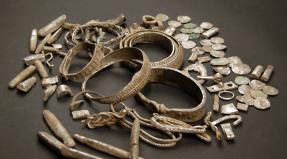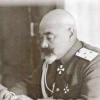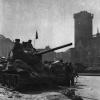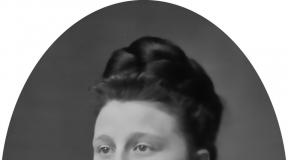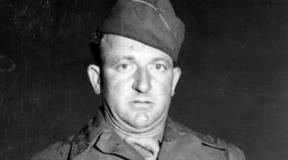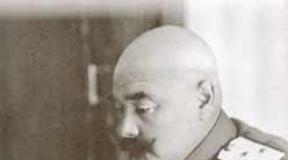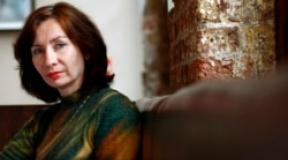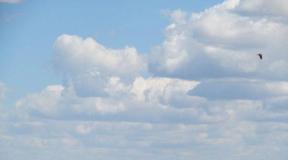Description of the breed Buryat-Mongolian wolfhound. Khotosho: how to care for a wolfhound at home How many Buryats live Mongolian wolfhound
Buryat Mongolian wolfhound or hotosho is an aboriginal guard dog of nomadic tribes. Differs in great growth, physical strength and excellent working qualities. Bright colors, thick coat make it possible to recognize the breed representative from afar.
Height at withers: males - 74 cm and above, females - 66 cm and above.
Weight: not in the standard.
Color: black and tan. Zone gray color, solid brown and red coat color are allowed. Possible small white spots in the area chest, tail tip and all limbs evenly distributed.
Eye color: brown and its variations.
Nose color: not in the standard.
General form: a massive dog with a strong build, hair of any length, but with a thick undercoat. Voluminous head and wide muzzle, hanging ears. Movements are free.

History of the Buryat-Mongolian wolfhound
The historical habitat of these dogs is the territory of modern Buryatia. They lived for centuries with nomadic tribes, taking on the functions of security guards... More wolfhounds trusted little children to be guarded by them. Physical data allowed men to take it to hunt... However, unlike the almost universal Caucasian Shepherd Dog, the Buryat-Mongolian wolfhounds were not used to graze livestock. They are believed to have served at Buddhist monasteries.
There is debate today about the true origins of the modern herd. However, even according to the results of archaeological excavations, it can be assumed that the Buryat-Mongolian wolfhounds are descendants of an ancient breed group.
Local Buddhist tribes treat dogs as a sacred being. Therefore, wolfhounds were included in the man's house. A lot of legends and beliefs are associated with them.
For example, their progenitor Sarama was the helper of God Indra. She had a black and tan color, which is popularly called "four-eyed" because of red spots on her forehead. Since then, the Buryats have believed in the divinity of dogs of this color, bringing happiness to the entire tribe. According to another legend, such a "four-eyed" dog asked the angry Buddha to leave some grains on the ears and saved humanity from hunger.
Buryat-Mongolian wolfhounds are an aboriginal breed. Man has only an indirect relation to its formation. All skills were formed during large gap time, people only made a selection according to working qualities, leaving the strongest with adequate behavior.
By the beginning of the 20th century, wolfhounds from Buryatia had become few in number, but already in the second half of the century, factory breeding and restoration of the breed began. The revival was carried out by Nikolai Batov. In the 80s of the last century, he removed several representatives of the breed from their natural habitat and settled them in his nursery for further breeding and increasing the population.
The modern cynological society represented by the RKF recognized the breed group of the Buryat-Mongolian dog in 2000. Breeders are working on international recognition in the ICF system, which requires a certain number of dogs with similar appearance, temperament, behavior and known origin of several ancestral tribes from official pedigrees.
The Buryat-Mongolian wolfhound (BMV) has several names: Mongolian Shepherd Dog, Banhar, Dog of the Huns, Tibet, but often Buryats use - hotosho... The meaning of this word in translation from the Mongolian language is "Yard dog", "Yard wolf".

Behavior and temperament
Positive qualities of BMW:
- Equilibrium,
- Lack of unmotivated aggression,
- Devotion,
- High level of intelligence,
- Unpretentiousness,
- Congenital protective qualities.
Negative qualities:
- Willfulness,
- Excessive independence.
BMW is essentially sanguine. They are not characterized by a sharp change in behavior, mood.

Who should start a hotosho
Bmw not suitable for beginners in cynology with rare exceptions. Not to become a full-fledged owner and a child. They require an individual approach to education. Best of all, wolfhounds get along with people who know how to show authority.
Athletes these dogs unsuitable... It is important for BMWs to be useful, so it is advisable to arm them. In addition, the natural talents of a watchman will manifest themselves with age.
Wolfhounds mature late, physical development along with psychological ends after 3 years. They should not be expected to work effectively until the specified age.
In the city, such a pet will feel good if it is provided with long walks at a leisurely pace and socialized correctly. He treats family members without aggression, behaves carefully with children. The rest of the pets is recognized as the property of the owner and considers it his duty to protect them from danger.

Khotosho perfectly tolerate frost, precipitation and summer heat. Naturally, when living on the street, it is necessary to build an aviary with a wooden booth inside and a canopy. Such dogs rarely enter the premises, if they are not accustomed to it. Even in snow storms, they prefer to sleep outdoors. Their dense undercoat helps to maintain an optimal body temperature and does not allow moisture to pass to the skin.
The BMW ration consists of foods common for a dog:
- Beef or chicken meat and offal (most of the portion),
- Cereals (buckwheat, rice),
- Small amounts of vegetables (exclude tomatoes),
- Cottage cheese, kefir, fermented baked milk, whey,
- Sea fish (rare),
- Chicken and quail eggs.
BMWs are not seen in the mass manifestations of food allergies. You can give treats in the form of large bones with cartilage, frozen tripe, dried liver, pieces of lung, chicken heart.
Large dogs need mineral supplements that do not exclude vitamins. Of the natural products that help maintain healthy joints and ligaments, gelatin and cartilage are noted.
The dog is fed either after a walk or active games, or 1.5-2 hours before going out. Otherwise, there may be intestinal volvulus. Feeding puppies depends on age. So, up to 4-5 months, the baby is served food several times a day, at least 4 times. By 9 months, 1-2 daily portions are left.
Breed wool of various lengths is rough to the touch, should not resemble cotton wool. This type of cover does not require much maintenance. It is allowed to wash with cosmetics for a dog if necessary, but BMW wool is self-cleaning. During the shedding period, they actively shed their old wool, which indicates the need for frequent combing with a comb and a slicker. BMW haircut is undesirable.
BMW has conscientious breeders remove dewclaws without fail. The procedure for their removal is carried out in the first days of the puppy's life, when the dewclaws are held on the cartilage, and there are no large vessels in them. Wounds are treated with brilliant green or other disinfectant.
In the presence of dewclaws in an adult dog, surgery occurs under general anesthesia. If it is decided to leave the fingers, then it is necessary to carefully monitor the claws on them and promptly shorten them with a special claw cutter for dogs.

Training
Urban BMWs must complete the General Obedience Course (OKD). The breed is late mature, and to lovers of service dogs (German and East European Shepherds, Giant Schnauzers, etc.), Mongolian aborigines seem slow and disobedient. In refutation, the breed breeders point to features nervous system their favorites.
Bmw it is common to make decisions independently, which is due to the origin and age-old traditions of keeping the nomads. It is important to establish contact with the dog, to become a leader for her, in order to achieve unquestioning obedience, coupled with trust.
When passing the training of the guard-protective service, the hotosho show excellent results. The legislation equates a dog with such skills and sizes to a weapon, therefore, before training, they check the stability of the dog's psyche and the ability to control the pet.

Health and longevity
Bmw live 12-14 years old and in their weight category are long-livers. They have good health, immunity resistant to infections. Most diseases are associated with the musculoskeletal system, there are problems with digestive system, just like others big dogs... There are such common diseases:
- Dysplasia of the hip joint (DTBS),
- Cataracts, lens opacities,
- Intestinal volvulus.
For the prevention of DTBS, it is recommended to keep the muscles in good shape by walking in the fresh air over rough terrain, swimming in water bodies. Jumping over obstacles, running on ice are contraindicated for puppies, sick and injured dogs. Develops the muscles of the chest, neck and back walking on loose snow.
You cannot raise a puppy in a house where the flooring is slippery (laminate, linoleum, ceramic tiles). This affects the joints and ligaments of the animal, increases the risk of sprains.

How much does a puppy cost and where can I buy
It is not difficult to buy a hotosho. There are nurseries in Moscow, Ulan Bator and several other cities. There is no information about foreign breeders. The National Club of the Buryat-Mongolian dog breed is registered in the RKF.
Puppy price: 30,000-40,000 rubles.
Breed photo
A selection of photos of Buryat-Mongolian wolfhounds.
With photos. Today we will talk about one of them. It will be about the Buryat-Mongolian wolfhound. What are these dogs? Are they large or not? What do they look like? You will know the answers to these questions if you read the entire article.
It is possible that you have even met such large dogs somewhere. The breeds, the name of which you might not know, interested you, and you decided to learn more about these unusual dogs.
Description of the dog
The Mongolian wolfhound is best known in Tibet and naturally in Mongolia. True, this breed is not recognized by the FCI. On the territory of the above states, the dog is revered as a sacred animal of the Tibetan lamas.
It has long been believed that such dogs accompanied the dead on their last journey, protecting them from evil. Sometimes the dog is called four-eyed. Why? Because of the bizarre color around the eyes: in place of the eyebrows, like another pair of eyes, not black, but red.
Mongolian large dogs
The breeds, the name of which may not mean anything to Russian amateur dog breeders, are in fact widely known among dog handlers around the world. This wolfhound is not very common in the world, but these dogs are very popular among the inhabitants of Mongolia. To breed the breed, they used the genotype. And to this day, the research of specialists in relation to this variety of dogs has not been completed.
However, even without this, it is clear that the Buryat-Mongolian wolfhound, the photo of which you see in our article, has many good qualities that are not inferior to popular breeds.

This dog is independent, although loyal to its owner, clearly follows his orders. The Mongolian wolfhound has a specific character: the dog loves to be in contact with people, while it does not favor those who are not part of the familiar environment. The dog lends itself well to training, learns commands well, is able to protect both property and the owner himself. To protect something or someone, the dog can use his teeth, although this happens very rarely, since the representative of this breed prefers only to detain the intruder before the owner comes, who will figure out what to do with him.
Usually such a dog is not the first to attack either dogs, much less people.
Despite the fact that the Buryat Mongolian wolfhound has a responsible and serious nature, he does not mind having fun playing with family members.
Such dogs love to swim in reservoirs, they are excellent swimmers. Periodically, the wolfhound requires a little attention from the owner. During such periods, the dog can behave like a small puppy.
Appearance
This dog is considered large by the standard. On average, a dog of this breed reaches 75 cm at the withers. Females are about the same, you rarely see a bitch below 65 cm. The weight of a breed representative can reach seventy-five kilograms.

Inhabitants of Mongolia often call these dogs "khotosho" (yard wolf). Despite the fact that such a dog is of impressive size, his psyche is balanced.
In representatives of the breed, both the body and the head are wide, very massive. The muzzle is well set. Withers and deep chest are two distinct features of the breed. The limbs of such a dog are powerful and muscular, as is the body. The coat is thick, there is an undercoat (also thick).
The advantage of the breed is that hairline such a dog is water-repellent. If a Buryat-Mongolian wolfhound that has just emerged from the water shakes itself off a couple of times, it will be practically dry. Another advantage of the breed is that the hair of the representatives does not gather in tangles. This makes these dogs a little easier to care for.

The Buryat-Mongolian wolfhound comes in different colors: brown, black and tan, wolf and red with white markings.
Features of the character of the representatives of the breed
Although during the choice between the owner and someone else, the dog, of course, will choose the first one.
Puppies of the Buryat-Mongolian wolfhound can carry out some commands. From early childhood, you need to drive such a dog throughout the entire territory of the economy, so that the baby at such a young age understands that he will need to be protected in the future.
Representatives of this breed accurately distinguish between animals from their own and foreign territory. If you keep a dog in the yard, then be aware that she may be asked to enter your house. At the same time, such a dog will try to behave well, so as not to embarrass anyone with his presence. He will find a quiet place for himself. Note that Buryat - Mongolian the wolfhound will never try to drive any other animal off the sofa or rug.
Such a dog respects the owner, but he will not allow yelling and misbehaving towards his person. Do not think that the dog will snap or rush at the owner, it will act differently. The wolfhound will simply show his donkey stubbornness, achieving what he wants to the last, ignoring any orders.
This kind of situation is more of a rarity than a rule. The Mongolian wolfhound will listen unquestioningly to the head of the family, if handled correctly. And the dog will, of course, be faithful to other family members, even children.

Although in relation to a child, the Buryat-Mongolian wolfhound (photo above) can show special ingenuity. After all, kids can not always objectively assess the safety of their own actions, so such a dog can be assigned as a guard even to the most inveterate tomboy.
For example, if a child goes deeper into the water, then the wolfhound will push the baby to the shore. Note that at this time he cannot be stopped either by the child's orders or shouts. And, of course, it will not be difficult for him to get a drowning child out of the water. Based on this, we can conclude that representatives of this breed are excellent nannies for children of all ages.
Note that such dogs have a great sense of humor, so they periodically play tricks on their owners. Also, one cannot fail to say that the breed is perfect for country houses. Such a dog will be an excellent watchdog. He will be able to guard the house and territory when you are absent.
Such a dog is extremely curious at any age, both as a puppy and as an adult. A snarling dog, most likely, he will perceive not as an enemy, but as an object for study.
Maintenance and care of representatives of the breed

The Buryat Mongolian wolfhound does not require special care. Since the dog has a thick coat, the pet needs to be combed out periodically so that it has a well-groomed appearance. In addition, brushing helps the animal to get rid of excess hair during the moulting period.
These large dogs are unpretentious in terms of keeping. They are not afraid of severe frosts. But if you plan to keep such a dog on the street, you need to make a booth for it to protect it from the rain.
Features of feeding such dogs
The dog is unpretentious even in food. The breed is omnivorous, but like other dogs, they need a balanced diet.
This is especially necessary in the first three to four years of a dog's life. It was at this time that the exterior of the dog was formed. If the nutrition is not correct, then the animal may develop dysplasia.

Of course, such a dog can be fed with ready-made feeds (it is advisable to take a premium class). Although experts have come to the conclusion that the composition of the Mongolian wolfhound is best suited for the products of the Nyutro Chois brand.
Supplements for full development
If you are planning to feed such a dog with natural food, then, of course, you need to think about vitamin and mineral supplements. Now there is a large selection of such products. What should you choose? There is a special fortified complex called "8 in 1". This supplement is available for dogs of different ages and sizes. For the Buryats, such a complex is just right. Although in this matter, you can additionally consult a veterinarian.

The rate of physical activity for this dog
Note that for health such a dog needs regular, and increased loads. If the muscles of the Mongolian wolfhound do not receive such training, then the dog, no matter how well it is fed, will still remain frail, sick. In addition, inactivity can affect the change in the character of the dog in the worst side... Therefore, experts advise keeping such a dog in the yard so that he has the opportunity to run, jump, chase someone.
The Mongolian wolfhound does not fall into the category of those dogs that travel to exhibitions. Note that it does not differ in any external features... But on the other hand, he is a reliable friend who can be entrusted not only with the protection of property, but also with taking care of children. If you treat this dog well and with love, then it will be devoted to you with all your soul.
Price for one representative of the breed
How much is the Buryat-Mongolian wolfhound? The average price is forty thousand rubles per puppy, although it all depends on the region in which you buy it. Also, the final cost is influenced by how famous the puppy's parents are.
A little conclusion
Whatever breed of dog you choose, be it a Mongolian wolfhound or someone else, the main thing is to be taken into account when considering the peculiarities of its breed. Speaking simple language- it is not necessary to make a hunting dog out of a guard dog. Allow the animal to realize its natural qualities, and it will thank you with faithful service.
Brief characteristics of the dog
- Other possible names: Wolfhound, Horoshi, Hotosho Nokhoi, Hotoch Nokhoi, Mongolian Dog, Mongol, Banhar, Bavgai, Huns Dog, Gartsh, Tibet, four-eyed black dog, Buryat-Mongol Wolfhound, Buryat-Mongolian Shepherd Dog.
- Adult growth: 62-70 cm.
- Weight: from 45 to 70 kg.
- Characteristic color: black with red or tan.
- Wool length: can be of three types: long, medium and short, but always with a dense undercoat and dense.
- Life Expectancy: 12-14 years old.
- Advantages of the breed: loyal, intelligent, obedient, active, good for children.
- Difficulties of the breed: gullible, shed profusely once a year.
- Average price: from $ 200.
History of the origin of the breed
Buryat-Mongolian wolfhound is the oldest a breed of guard and herding dogs. To this day, dog breeders cannot come to a consensus and decide who appeared first: the Tibetan mastiff or the Mongol. Unfortunately, the breed is little known outside Mongolia and Buryatia.  But sometimes these dogs can be found in Siberia, Tibet and China.
But sometimes these dogs can be found in Siberia, Tibet and China.
Despite its thousand-year history, the breed is recognized exclusively by the Russian Kennel Federation, and this happened only in 2000. And the breed standard was registered even later, in 2006.
Purpose of the breed
Originally, these large and shaggy dogs were sacred dogs at Buddhist monasteries. They also took part in various rituals of local shamans.
The second name of the Buryat-Mongolian wolfhound is khotosho, or khotoche, which translates as “the dog of the yard” or “the dog guarding the courtyard”.  it sensitive and attentive guards, who will not let anyone from outsiders pass by and will certainly inform the owners about them.
it sensitive and attentive guards, who will not let anyone from outsiders pass by and will certainly inform the owners about them.
In their homeland, the Mongols are widely used to protect not only houses, but also herds. The translation of the prefix "khoto" from the Western Mongolian dialect, which means "corral", speaks about their shepherd qualities. That is, khotoshi are also used by shepherds to corral the herd.
Developed intuition allows using this wolfhound in rescue and search activities. And the scent and dexterity make the dog a good hunter. Quite often one could meet hotosho in the garrisons, where they carried out guard duty, and in their free time they carefully nursed the officers' children. And also this loyal companion, bodyguard and big four-footed friend who loyally serves the whole family.
Description of the nature of the breed
Buryat-Mongolian wolfhounds in appearance resemble lazy and clumsy hulks. But in reality, they are easy-going and very agile and playful. Hotosho are balanced and they are not characterized by mood swings.
They are great kind-hearted people who can sometimes be too gullible and therefore tend to mistakenly perceive the real intentions of strangers. Although initially they are wary and distrustful of strangers.
 Thanks to the same kindness, they make wonderful affectionate and attentive nannies. They treat other animals like real shepherds, closely observing their behavior. The Mongols do not have a habit of conflicts, and they will never be the first to sort things out.
Thanks to the same kindness, they make wonderful affectionate and attentive nannies. They treat other animals like real shepherds, closely observing their behavior. The Mongols do not have a habit of conflicts, and they will never be the first to sort things out.
The predominant trait of the Mongolian wolfhound's behavior is curiosity and attention. They quickly notice the slightest changes in the world around them, about which they will certainly rush to notify the owners.
Hotosho spontaneous, playful and have a very subtle sense of humor, who are sometimes able to bring to a heart attack those who are not familiar with their demeanor. They love to corner future partners for games, rushing past them with a rather frightening look.
Unobtrusive Buryats will always find a place for themselves next to the owner, even in a small room, and they will do it so as not to disturb anyone with their presence. They feel comfortable in any conditions and, with proper maintenance, can be close to their beloved owner, even in a cramped apartment. Although they are not intended for this.
Breed video review
What are the Buryat-Mongolian wolfhounds, what kind of character they have, what they are intended for and much more, see the review of the breed on the video.
How to choose a puppy
The hotosho puppy looks like a well-fed bear cub with four eyes. And all because in this breed, light eyebrows on a black face stand out well. A healthy and well-groomed strong man is covered with thick and shiny hair. Hanging ears should be clean and the nose damp and cold.

The exception is puppies that have recently woken up. Elastic, but soft and not swollen tummy indicates that at the moment the puppy does not have worms. Toddlers should be active in frolicking and curious about new subjects and strangers.
If you look at the parents, you can guess what your pet will be like when it grows up. By the way, it is better to acquire a Mongolian at the age of three months. Like many large breeds, it takes a little longer for the HotoSho to become independent and absorb all the skills that the mother can pass on to them.
Wherever you buy a puppy, find out if it has been made necessary vaccinations... If necessary, do not delay the visit to the veterinary clinic for vaccinations. If you are purchasing a purebred puppy with a pedigree, then check the presence of documents and brands on the dog's body.
Names of dogs
Nicknames like Sharik and Tuzik are hardly suitable for khotosho. These should be names that your pet can wear with greatness, and you pronounce them with pride. You can accustom a puppy to a nickname quite quickly if you pronounce it at the time when you are going to feed him or treat him with something tasty.
Try to give your pet a name that is easy to pronounce so it will be easier for the dog to perceive. Nicknames such as Zangar, Des, Darman, Alva, Elba, Terra, Khan, Sheikh, Khatis, Aina, Gerda and so on are suitable for the Buryat-Mongolian wolfhound.
Once a year, before the beginning of summer, a khotosho with any type of coat has a very abundant shedding. Wool literally slides off them in layers. Daily brushing and plucking of hair by hand (manual trimming) will help to give the dog a proper look during this period.
Such a dog is bathed once or twice a year. Khotosho will gladly enjoy this procedure in natural waters, as they are excellent swimmers. Particular attention should be paid to the hanging ears of the dog, which you need on a regular basis.
Although Mongols can get along in an apartment, it is still recommended to take them into private houses with their own courtyards. This will make the dog feel much freer and more comfortable. You should not plant a hotosho on a chain, for this there are other breeds that are more intended for this. Instead, make your pet an open-air cage with a canopy and a spacious booth.
The final physical growth of the Mongol stops only closer to four years. For normal muscle development throughout the entire period of formation, the dog requires sufficient physical activity.
Possible health problems
Since the breed has not undergone human intervention and forced selection, the Buryat-Mongolian wolfhounds have no health problems, and their immunity is able to withstand many diseases. But with overfeeding or excessive exertion, quite serious illness elbow or hip joints, that is.
A limp and pain in the paws may be a sign. You can only confirm the diagnosis by making an x-ray to your pet. If you do not follow the ears well, it may appear, which the dog will immediately inform about by starting and trying to scratch sore ear... With an advanced form, an unpleasant odor appears from the ears.
Nutrition for a puppy and an adult dog
Many health problems and general condition of the dog arise from improper nutrition. Some owners strive to treat the pet with delicious, in their opinion, smoked meats or sweets. Of this absolutely not do. And also you can not turn a dog into a pig, throwing it all the waste, which sometimes may not be entirely fresh. And then they completely forget to feed.
Normal, proper nutrition implies regularity and balance. At least a third of the volume should be occupied by protein products, namely lean meat (veal, chicken, beef or turkey), including offal or sea fish. The rest of the volume is filled with carbohydrates, which include cereals and vegetables. Useful in the diet of the dog will be dairy products as well as boiled eggs.
You need to feed an adult dog twice a day, and puppies more often, depending on. Try to place the bowl of food on a higher level and preferably at chest level. Also, provide your pet with a container of clean water. It is better to use bones or apples as a treat.
Briefly about training
Khotosho smart and give in rather quickly. But sometimes they tend to be lazy and stubborn. To prevent this from happening, it is recommended to turn training into a game. And also the whole process of education should be more reminiscent of friendly agreements.
 So it will be easier for you, and the dog will be more interested in perceiving the requirements. After the pet has executed the commands do not forget to praise and treat him with something... You shouldn't raise your voice against the Buryats, let alone use physical force. From this he will simply stop trusting you.
So it will be easier for you, and the dog will be more interested in perceiving the requirements. After the pet has executed the commands do not forget to praise and treat him with something... You shouldn't raise your voice against the Buryats, let alone use physical force. From this he will simply stop trusting you.
You can go with your Buryat-Mongolian wolfhound such special courses as security guard or search and rescue. As a rule, dog handlers speak flatteringly about such students, who are able to easily assimilate information and memorize lessons.
Advantages and disadvantages
Good-natured Buryat-Mongolian wolfhounds are only so formidable and frightening in appearance. When you get to know each other better, you will find out how much they affectionate and loyal. It is not scary to leave a small child with them, and when he grows up, he can easily control his big four-legged friend.
At any age, khotosho gladly respond to an offer to play. They are agile and dexterous, which you can't tell right away. Even in relation to other dogs, they do not bully, but try to involve them in the game. True, sometimes in a rather strange way.

Such dogs are easy to care for and picky about food and living conditions. Choosing one leader for themselves, they nevertheless serve all faithfully and obediently, who belongs to the owner's family. Buryats are very easy to educate and train in all the necessary commands.
True, sometimes you can stumble upon stubbornness and laziness. For many centuries, these dogs have become accustomed to being close to a person and being his reliable friend and bodyguard.
Buryat - Mongolian wolfhound has a special reputation in the Russian state. There are many legends about this breed in certain social circles. There is a belief that dogs of this breed are some kind of guides for dead people. They escort them to the afterlife. Not everyone will be able to immediately recognize this. legendary dog... Many lovers may confuse him with the Caucasian Shepherd Dog, but there are also those who immediately recognize this wolfhound, in whose veins a lot of wolf blood flows.
History
 Representatives of this breed lived among people for a very long time, they were loyal companions and irreplaceable companions. They lived mainly in Buryatia, Siberian lands. There were also enough of them in China and the lands of Tibet. But then they disappeared. However, later dogs of this breed began to live among people again.
Representatives of this breed lived among people for a very long time, they were loyal companions and irreplaceable companions. They lived mainly in Buryatia, Siberian lands. There were also enough of them in China and the lands of Tibet. But then they disappeared. However, later dogs of this breed began to live among people again.
The breed was recreated anew by a man named Nikolai Batov. The fact is that from a young age he heard from his parents a lot interesting stories about the legendary Buryat - the Mongolian wolfhound. When this man grew up, he began to dream of returning this breed. After several unsuccessful attempts, the dog breeder managed to achieve what he wanted. The first small wolfhounds were born in the late 90s. Then certain standards were developed, special kennels were created and, of course, the price for wolfhound puppies was formed.
Such a dog has many names and Buryats - the Mongolian wolfhound is far from the only one. It is also called wolfhound hotosho, sometimes just a Mongol or Mongolian Shepherd Dog, is quite often called a Tibetan dog. The most common name for such a dog is hotosho. Translated from the Buryat language, this means a dog that guards the yard. According to some reports, such dogs often lived in Buddhist monasteries. Buddhists seriously believed that dogs of this breed were sacred.
general characteristics
- Compared to other dogs, representatives of this breed look much larger, and sometimes even taller than their counterparts.
- The dog is sturdily built, it has a fairly massive skeleton, all muscle groups are naturally well developed.
- His skin is quite thick, but at the same time elastic.
- The dog's head is fairly proportional to the body. Has a powerful skull and cheekbones. Decently developed lower jaw... The dog's lips are quite thick and fit tightly to each other. The nose is usually large and black in color. The teeth are large, white, located in the mouth without gaps. The dog has a scissor bite. The eyes are small, usually oval in shape. The color can be anything from bright amber to hazel. They are usually located widely. As for the ears of the representatives of this breed, they have a triangle shape and are medium in size. Usually they are hanging and tend to rise on the cartilage when the dog is alert.
- The dog's neck is powerful in length, approximately equal to the head.
- The chest of this breed is always wide, it can be oval or round in shape.
- The back is broad, with well-developed muscles.
- If you look at the dog from the front, you can see that the front legs are straight and parallel. The shoulder blades are of decent length and oblique.
- The tail of the dog is high and when the dog is calm, it is lowered down. In motion, the tail usually takes the shape of a sickle, sometimes slung over the back.
- The coat is straight and coarse. However, the undercoat is soft and dense. On the head and front of the legs, the hair is usually short and tight.
Character
- These wolfhounds do well in any setting. They can perfectly fit into a family or live on the street.
- By nature, the dog is not inclined to sort things out with his fellows. If a puppy of this breed sees a barking dog, it looks at it with interest rather than with fear or anger. As a rule, most dogs will not want to mess with adults. After all, such a dog is not simply called a wolfhound.
- He has a natural alertness and therefore can be an excellent watchman or guard.
- Sometimes he shows a little excessive independence, easily lends itself to any training.
- One of her favorite activities is swimming, she just loves water. The dog is kind and always likes to play in nature.
- Representatives of this breed treat children with love and can easily perform the functions of a nanny. Such a dog is very responsive to affection, even despite its fighting origin. However, they do not have the habit of imposing themselves on a person, if the owner is not in the mood, then the dog will immediately understand this and leave home.
- If an unreasonable physical impact is applied to a dog, then he will definitely do something in response. Most likely, the dog will ignore the one who undeservedly hit it, but in spite of everything it is not typical for him to throw himself at the owner.

The dog, in general, then unpretentious... The coat should be brushed no more than once a week, and the dog should not be washed more than once a month. Does not require the owner of the equipment for a special place to sleep, can sleep anywhere. At least on the rug by the door.
In food, he, too, will not pose as fussy. However, it should be remembered that different vitamins trace elements are necessary for such a dog. Despite such simplicity in the content, it should be remembered that if the owner expects exceptional devotion and love from the dog, then the care should be appropriate.
Health
 A dog of this breed lives from 13 to 15 years old... He is in very good health, both physical and mental. In addition, he is not susceptible to any hereditary diseases. However, to maintain such high performance the dog needs a fairly large physical activity.
A dog of this breed lives from 13 to 15 years old... He is in very good health, both physical and mental. In addition, he is not susceptible to any hereditary diseases. However, to maintain such high performance the dog needs a fairly large physical activity.
It is better to immediately give him space for regular walks. If the required loads are not provided, then the dog will be deprived of the possibility of physical development, which will negatively affect its general condition even in spite of proper nutrition. Excess weight can cause severe joint dysplasia in this breed.
Nicknames
The name for the wolfhound, which reaches 70 cm at the withers and weighs up to 70 kg, should emphasize the massive dimensions of the dog. Svarog, Rex, Romulus, Ares or Werewolf are best suited. Naturally, the dog should respond well to its nickname and should accustom the dog to the name from a very young age.
Photo








Buryat-Mongolian wolfhound

Sun, 12/31/1989 - 12:00
Life span
The Buryat Mongolian wolfhound is a multifunctional animal that will come in handy as a good watchman, dexterous hunter, loyal and reliable companion, as well as a loving nanny for children. In Buryatia and Mongolia, there is a belief that these interesting and stately animals have four eyes (expressive black eye frames), and bring happiness to their owners. Excellent mental abilities, balanced character and the ability to quickly adapt and adapt to any habitat makes the Buryat-Mongolian wolfhound a wonderful family friend!
History of the breed
There are many legends and myths about these beautiful dogs. After its complete disappearance, the breed was restored at the end of the 20th century by Nikolay Batov and Marika Teregulova. The Buryat Mongolian wolfhound is one of the most popular dogs today in Mongolia, Tibet and Central Asia, where it is considered a sacred and incredibly wise creature. In their homeland, the Buryat-Mongolian wolfhound is called "khotosho", "yard wolf" and "yard dog". They are prized as experienced watchmen, shepherds and guides, as well as for their loyalty and commitment to their master.
Despite the fact that the Buryat-Mongolian wolfhound is a kind of robust man, his external physique is surprisingly proportional to the general format of the animal. The height of the dog reaches about 75 cm with a weight of 70 kg. There are two types of breed, which are divided according to the length and structure of the coat - long-haired and short-haired. The dog's eyes are usually oval, light amber to dark brown in color. The Buryat-Mongolian wolfhound can be black, red, gray, brown and black and tan.
Character and temperament
The strong and stocky Buryat-Mongolian wolfhound is calm, witty and sweet kind. He puts the protection of his territory and family members in the first place. Is a comfortable roommate for other pets. Also, a dog of this wonderful breed has brilliant intellectual abilities and an interesting sense of humor. It is not for nothing that the Buryat-Mongolian wolfhound is also called “the dog of the yard” - this characterizes the animal 100% correctly. There is a description of the breed: "he is independent - like a Caucasian shepherd dog, swims like a Newfoundland, plays like a Labrador."
Health and disease
The muscles and joints of the Buryat-Mongolian wolfhound should always be in good shape - this is facilitated by daily physical exercises, sufficient loads and training. Wide space for running and walking is a must for the health of the animal. You also need to carefully monitor the dog's weight - its excess can be the cause of such an undesirable disease for the breed as dysplasia of the joints. In general, the dog has a fairly strong immunity and the absence of hereditary diseases.
The main position in caring for the Buryat-Mongolian wolfhound is tracking the thick hair of the animal. The advantage of this breed is that your pet's coat has a water-repellent structure. The Buryat Mongolian wolfhound requires frequent combing of the coat, although it does not tend to tangling. The conditions of keeping in the yard are more suitable for the animal than in a small apartment. The “yard wolf” is a surprisingly versatile dog with excellent pedigree qualities, which is unpretentious and not capricious in its care and maintenance.
Dresiruvannya, trenuvannya
The Buryat Mongolian wolfhound has a penchant for independent decision-making, surprisingly quickly and easily learns everything new. Therefore, the upbringing process is pleasant and positive! With dignity they pass such complex training courses as search and rescue and guard work, passing them with excellent marks. The Buryat-Mongolian wolfhounds obey their master unquestioningly and attentively. But the dog does not tolerate an increase in tone at all, is a supporter of a soft and clear system of relationships.
The Buryat-Mongolian wolfhound is distinguished by unpretentiousness in food consumption, but still requires a varied and balanced diet. For this mighty giant fit like natural composition food, which is based on meat, various cereals, vegetables and dairy products, as well as high-quality dry food. Vitamin and mineral complexes are a must for your pet. They will help maintain the power, beauty, greatness and well-being of the Buryat-Mongolian wolfhound!
- 95 views

